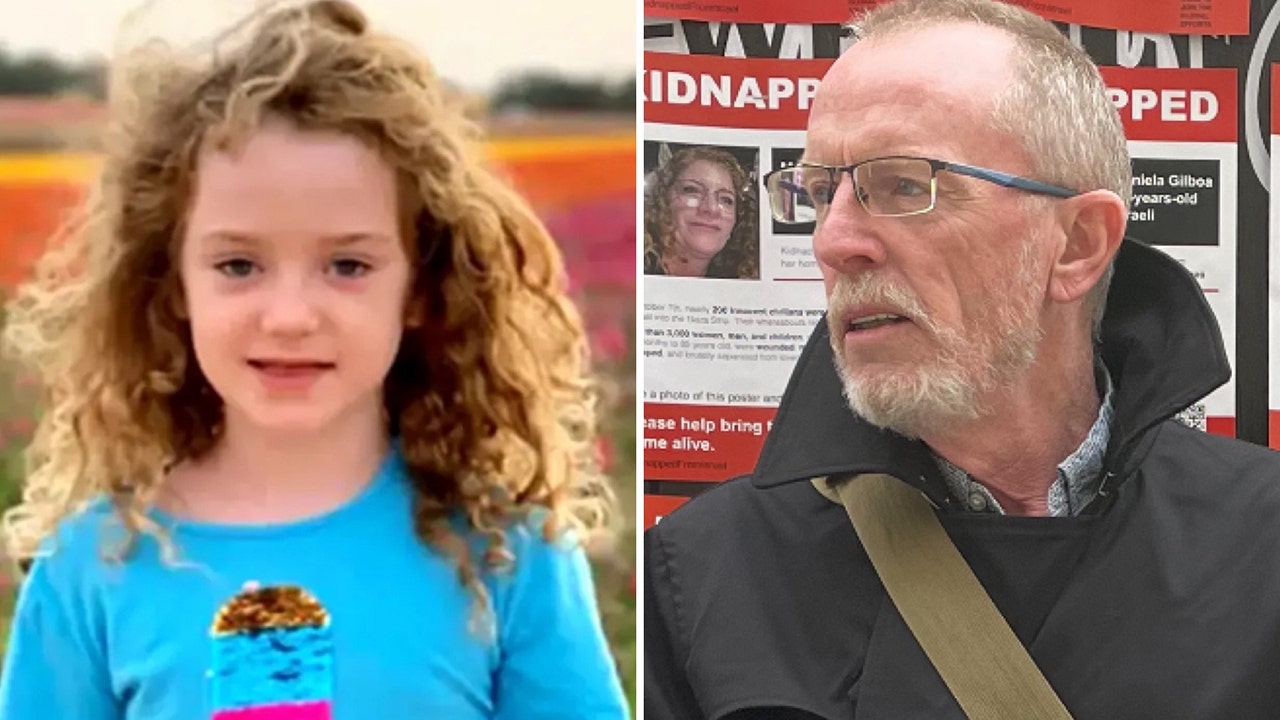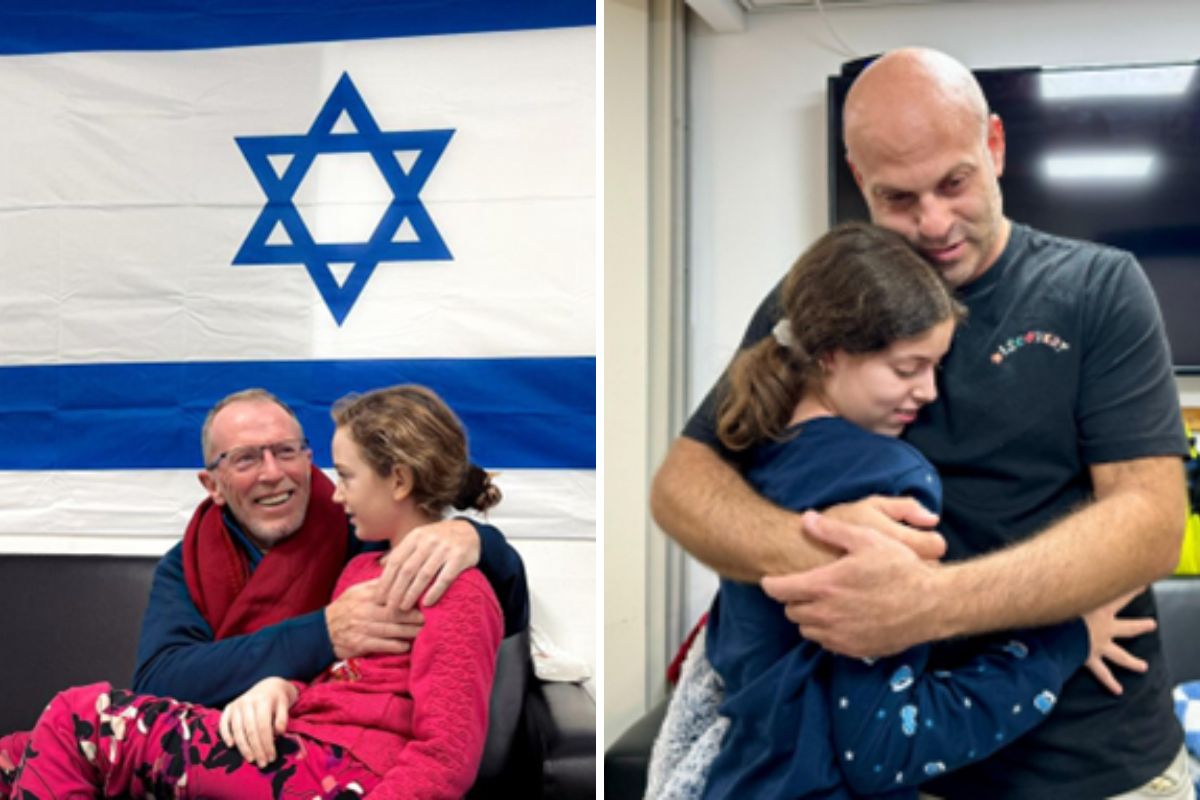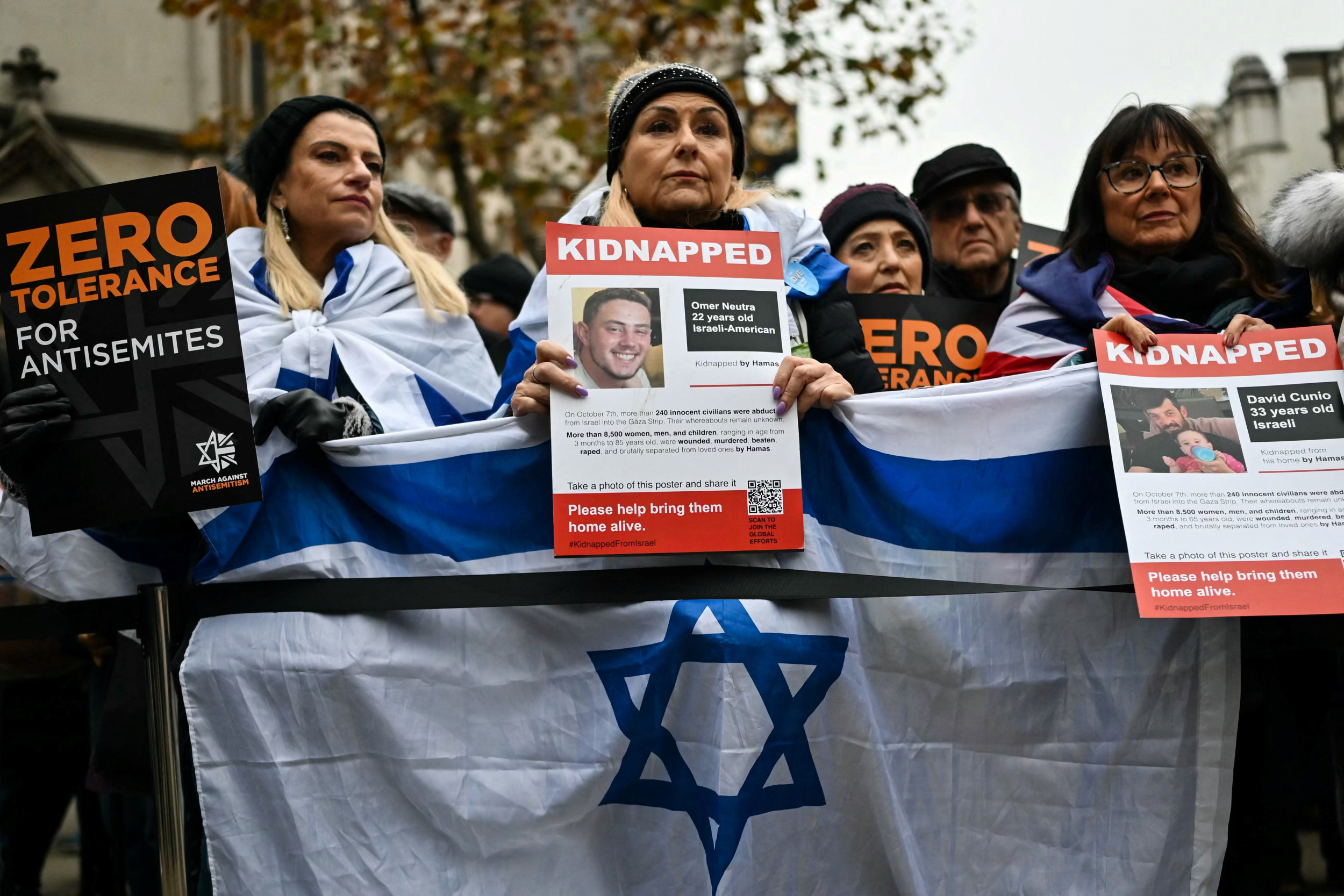:quality(70)/cloudfront-us-east-1.images.arcpublishing.com/adn/CZO6FROSMRILBNBKZAXGUCVZUM.jpg)
A girl takes a photograph of a poster showing Abigail Edan, a 4-year-old with American and Israeli citizenship who was taken hostage, during a protest in Tel Aviv on Saturday. (Heidi Levine for The Washington Post) JERUSALEM - Families in Israel, the occupied West Bank and around the world prepared to welcome home loved ones on the third day of a fragile humanitarian pause in Gaza that has seen Hamas exchange hostages for Palestinians held in Israeli prisons. Among the hostages released by Hamas on Sunday was 4-year-old Abigail Edan, a U.S.-Israeli citizen whose parents were shot dead by militants on Oct. 7, when some 1,200 people were killed in the bloodiest day in Israel’s history. “She’s been through a terrible trauma,” President Biden said as he announced her release. “Her mom was killed in front of her . . . [her dad] was gunned down as well while trying to shield little Abigail.” Edan was one of 14 Israeli hostages freed Sunday, along with three others, according to military officials involved in the transfer. Israel released 39 imprisoned Palestinian women and teens in exchange. Hamas has now released 58 hostages over the past three days, including Thai and Filipino citizens. With the four-day truce due to expire Tuesday morning, aid groups rushed to increase deliveries to the enclave and Gazans braced for warplanes to return to the skies. Israeli military leaders have pledged to resume attacks inside the strip after the negotiated break, even as aid groups have pleaded for time and a growing chorus of Israelis have pushed to extend the pause, hoping to secure the freedom of more captives. Under the terms of the agreement, the pause can be extended by a day for every 10 additional hostages released by Hamas. “We will return immediately at the end of the cease-fire to attacking Gaza,” Lt. Gen. Herzi Halevi, the Israeli army’s chief of staff, said in a meeting with troops inside of Gaza on Saturday. The prospect hangs heavily over battle-weary Gazans, who have emerged from basements and shelters in recent days to take stock of the widespread devastation wrought by Israeli airstrikes and fierce ground battles between Israeli troops and Hamas fighters. More than 13,000 people have been killed and thousands more are missing or stuck under rubble after nearly two months of war, according to the Gaza Ministry of Health, which is no longer able to fully count the dead. Survivors are scrambling for food, water and medicine. “We can do nothing to prepare,” said an aid worker in Khan Younis, in the south, where many of Gaza’s 1.7 million displaced people have sought refuge. “Resources are basically the same. We are ready, but not ready,” he told The Washington Post, speaking on the condition of anonymity to protect his security.
:quality(70)/cloudfront-us-east-1.images.arcpublishing.com/adn/PDFSLSDYFPEIGAX7F7DQWLINEA.jpg)
Trucks carrying humanitarian aid enter Gaza Strip from Egypt in Rafah as a temporary ceasefire went into effect Friday, Nov. 24, 2023. (AP Photo/Hatem Ali) The pause in bombardments has enabled aid agencies to increase distribution of emergency supplies to the highest levels since Israel imposed a complete siege on Gaza in response to Hamas’s surprise attack. Dozens of military cargo planes carrying food, medicine and shelters are landing every day at Egypt’s Arish airport, about 30 miles from the border with Gaza, said Jassem Abdul Rahman from Qatar’s foreign ministry to The Post on Sunday during a press tour of the area. Planes from Qatar and Saudi Arabia lined the tarmac. While the Rafah crossing into Gaza is just an hour’s drive from the base, it can take days for supplies to pass the screenings necessary to enter the territory, according to Qatari officials overseeing the delivery. Other officials at the base said the influx has overwhelmed Egyptian border authorities charged with clearing the deliveries. “Innocent children in Gaza are suffering greatly as well,” Biden said in his remarks Sunday. “And we worked urgently, urgently to take advantage of the pause to surge aid into Gaza.” Gaza is still receiving less than half of the average daily supplies that came in before the war, and the uptick in aid has done little to slow the humanitarian crisis in the densely-packed territory. Clean drinking water remains in short supply. Communicable diseases are spreading fast, health workers say, and horrific wounds are going untreated. “No amount of aid that will come in the four days will be sufficient to get the health sector to function at a decent level,” Tamara al-Rifai, a spokeswoman for the U.N. agency for Palestinian refugees, told The Post by phone from Amman, Jordan. Aid organizations at Arish said they are hoping to build additional medical facilities inside Gaza during the calm but are struggling to get supplies and personnel across the border. The Qatar Red Crescent is planning to build and staff a field hospital in southern Gaza. The United Arab Emirates and Jordan have announced similar plans.
:quality(70)/cloudfront-us-east-1.images.arcpublishing.com/adn/RXDAW7NFMP3LPHXPTST4HONRLM.jpg)
Palestinians line up for cooking gas during the second day of the temporary ceasefire between Hamas and Israel in Khan Younis, Gaza Strip, Saturday, Nov. 25, 2023. (AP Photo/Fatima Shbair) Across Gaza’s south, Palestinians spent the weekend queuing in line for meager rations of fuel, gas and water. In some areas, whole neighborhoods have been obliterated. Internet and phone connections remain patchy and unstable, leaving families in the dark about the fate of loved ones in other parts of the enclave. “Do NOT move to the north of the strip,” the IDF said in a statement on X, formerly Twitter, on Sunday. The military said that accessing the sea or coming within “1 kilometer of the border with Israel” was also prohibited. Israeli forces on Sunday fatally shot one man and injured six others in the Meghazi refugee camp in central Gaza, according to Mohammad Haj, the spokesperson for the Al-Aqsa Martyrs Hospital, where victims were taken. The Palestine Red Crescent said in a statement that the deceased and at least one of the injured were farmers. The Post could not verify the claim. “The circumstances of the incident are being reviewed,” the Israel Defense Forces said in a statement. Despite warnings to stay put, Gazans desperate to see family and what’s left of their homes are still trying to return to the north, where a majority of the enclave’s 2.2 million people lived before the war. Rami Abu Marhal, 36, told The Post by phone that he gambled on going back Friday, the first day of the truce. He spent most of the war in his home near al-Rantisi hospital, a Gaza City hospital forced to evacuate after intense fighting and bombardments earlier this month, before fleeing last week to a U.N.-run school in the center of the strip. On Friday, he was with a group of men advancing slowly on foot when they approached an Israeli checkpoint. Without warning, he said, bullets started flying. Abu Marhal said he did not know if the fire came from a tank or sniper and quickly fled. The Associated Press said two people were killed in a similar incident Friday; it was not immediately clear if the two were the same. The IDF did not comment on the deaths reported Friday but released a statement saying its forces were “stationed along the designated operational lines of the pause.” Unable to continue north, Abu Marhal asked friends who had remained in Gaza City to check on his home. “But they were exposed to a barrage of bullets that almost killed them, so they retreated,” he said. “I was hoping that this truce would include me,” he added. The bloodshed continued elsewhere in the Palestinian territories. Israeli forces killed at least seven Palestinians in the West Bank between Saturday and Sunday, according to the Palestinian Ministry of Health based in Ramallah. Palestinians walk by a damaged building following an Israeli army operation in Jenin refugee camp, West Bank, Sunday, Nov. 26, 2023. Israeli forces operating in the occupied West Bank killed at least eight Palestinians in a 24-hour period, Palestinian health officials said Sunday. (AP Photo/Majdi Mohammed) Five were killed overnight in the Jenin refugee camp, where the Israeli military said it also arrested 21 others in an operation against local militants. At least 215 Palestinians, including 55 children, have been killed by Israeli forces in the West Bank since Oct. 7, according to the U.N. Office for the Coordination of Humanitarian Affairs (OCHA). Another eight have been killed by Israeli settlers in the West Bank; four Israelis there have been killed in attacks by Palestinians, OCHA said. The third round of hostage releases appeared to play out smoothly Sunday after an 11th-hour delay Saturday threatened the truce. On Sunday evening, Avital and Nahum Kirtsch joined other hostage families in Tel Aviv to rally for the release of their daughter and son-in-law. “It helps me to believe that they will come back,” Avital said. “And every day it is a fight.” Rimon Kirsht Buchshtav and her husband, Yagev Buchshtav, were taken hostage from their home in Kibbutz Nirim. “Mom, I love you. I’m so sorry I’m not there for you,” Rimon told her mother in a final WhatsApp message on the morning of Oct. 7. In late October, Hamas released a video of three female hostages - Rimon was among them, looking frail and without her glasses. Late Friday, Avital received a message from an acquaintance, who was one of the first Israeli hostages to be released. Rimon and Yagev are together in an underground bunker, Avital was told. “It was the first time that I didn’t sleep at night not because I was afraid or cried, but because I was happy,” she said. - - -
:quality(70)/cloudfront-us-east-1.images.arcpublishing.com/adn/CZO6FROSMRILBNBKZAXGUCVZUM.jpg)
:quality(70)/cloudfront-us-east-1.images.arcpublishing.com/adn/PDFSLSDYFPEIGAX7F7DQWLINEA.jpg)
:quality(70)/cloudfront-us-east-1.images.arcpublishing.com/adn/RXDAW7NFMP3LPHXPTST4HONRLM.jpg)
:quality(70)/cloudfront-us-east-1.images.arcpublishing.com/adn/AG4DBB6WV5NBONDC3WISFTH244.jpg)



















